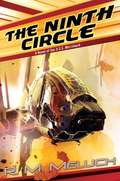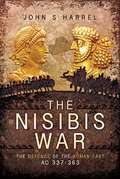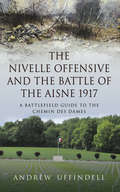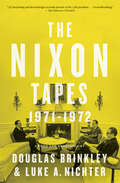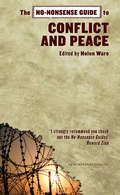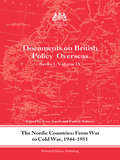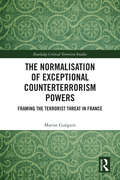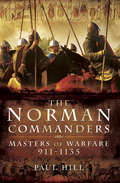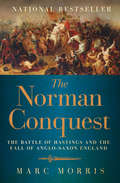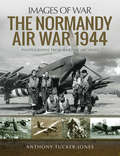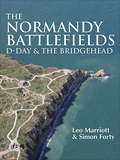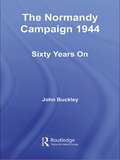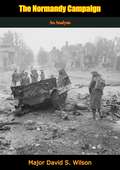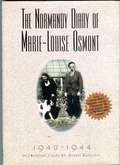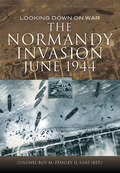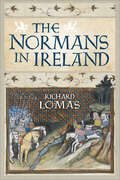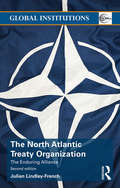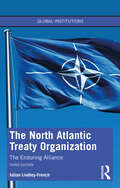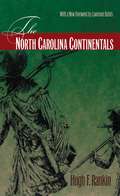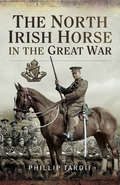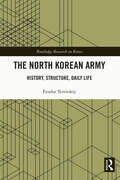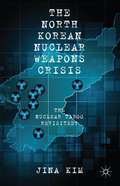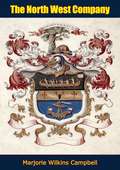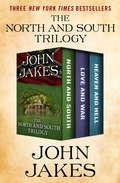- Table View
- List View
The Ninth Circle (Tour of the Merrimack #5)
by R. M. MeluchWhen peace exists between the Terran and Palatine Empires, the troops aboard the U.S.S. Merrimack are always on edge, waiting for the Roman forces to violate the treaties in a sneak attack on some unprotected corner of the galaxy. But as far as anyone can tell all is quiet in the universe. Admiral John Farragut no longer walks the decks of the space battleship he commanded for so many years, his time now spent on Earth with his wife and child. Captain Calli Carmel has taken Farragut's place on the ship they've both called home for so long, and she commands the Mack firmly and fairly. Others, too, are absent from their posts. Lieutenant Glenn Hamilton is on a well-deserved leave, traveling with her husband, Dr. Patrick Hamilton, the ship's xenolinguist. They're aboard a League of Earth Nations ship on a scientific expedition to an Earthlike world named Zoe, located at the back of beyond at the edge of the galaxy. Glenn is resigned to a quiet and boring run--a chance for Patrick to do what he does best while Glenn takes a back seat and tries not to upset the researchers, who can't abide any military presence. But when their vessel is attacked upon arrival, Glenn is forced to seize control, managing to crash-land the ship with no loss of life. Then--thanks in part to Patrick and Glenn--the expedition discovers that life on Zoe is DNA based, an extremely rare occurrence. So when alien invaders are also discovered on the planet, and they begin wreaking havoc on both the humans and native life-forms, it is only natural for Glenn Hamilton to call on the U.S.S. Merrimack for help. Meanwhile, on the Roman world of Phoenix, the hazing of a new recruit has gone horribly wrong. His untimely death leads the remaining members of his unit into permanent exile. Condemned to the hell of being considered dead to all they hold dear, they steal a cutting edge spaceship and, dubbing themselves the damned of the Ninth Circle, become pirates. Their leader is a man called Nox--formerly known as John Knox Farragut--younger brother to the admiral. Inevitably, both the Ninth Circle and the Palatine Empire find their way to Zoe. And suddenly all sides are on a collision course to determine the fate of this uniquely valuable planet....
The Nisibis War: The Defence of the Roman East AD 337–363
by John S. HarrelThis study of the Roman Empire&’s combat with its rivals to the east examines the evolution of ancient military strategy and tactics. During the Perso-Roman wars of 337-363, Roman forces abandoned their traditional reliance on a strategic offensive to bring about a decisive victory. Instead, the Emperor Constantius II adopted a defensive strategy and conducted a mobile defense based upon small frontier forces defending fortified cities. These forces were then supported by limited counteroffensives by the Field Army of the East. These methods successfully checked Persian assaults for twenty-four years. However, when Julian became emperor, his access to greater resources tempted him to abandon mobile defense in favor of a major invasion aimed at regime change in Persia. Although he reached the Persian capital, he failed to take it. In fact, he was defeated in battle and killed. The Romans subsequently resumed and refined the mobile defense, allowing the Eastern provinces to survive the fall of the Western Empire. In this fascinating study, John Harrel applies his personal experience of military command to a strategic, operational, tactical and logistical analysis of these campaigns and battles, highlighting their long-term significance.
The Nivelle Offensive and the Battle of the Aisne 1917: A Battlefield Guide to the Chemin des Dames
by Andrew UffindellThe notorious plateau of the Chemin des Dames saw some of the heaviest fighting of the First World War. Situated just 100 km north-east of Paris, it was the scene in 1917 of the bitterly-controversial Nivelle offensive, which is remembered today as one of the worst disasters in military history.For battlefield tourists, the Chemin des Dames is among the most fascinating sites on the entire Western Front, yet until now there has never been a detailed English guide to the actions that raged there in 1917. This new book by Andrew Uffindell fills that gap: as well as demolishing the many myths about the Nivelle offensive, it enables readers to explore the remarkable battlefield for themselves. Five tours supplemented by forty-six stops at individual places of interest provide an exceptional insight into the struggle for the Chemin des Dames. Illustrated with a wealth of maps and photographs, this book will be essential reading for anyone interested in the First World War.
The Nixon Tapes: 1971–1972
by Douglas Brinkley Luke NichterThe famous -- and infamous -- Nixon White House tapes that reveal President Richard Nixon uncensored, unfiltered, and in his own words President Nixon's voice-activated taping system captured every word spoken in the Oval Office, Cabinet Room, and other key locations in the White House, and at Camp David -- 3,700 hours of recordings between 1971 and 1973. Yet less than 5 percent of those conversations have ever been transcribed and published. Now, thanks to professor Luke Nichter's massive effort to digitize and transcribe the tapes, the world can finally read an unprecedented account of one of the most important and controversial presidencies in U.S. history. The Nixon Tapes, with annotations and commentary by Nichter and Professor Douglas Brinkley, offers a selection of fascinating scenes from the year Nixon opened relations with China, negotiated the SALT I arms agreement with the Soviet Union, and won a landslide reelection victory. All the while, the growing shadow of Watergate and Nixon's political downfall crept ever closer. The Nixon Tapes provides a unique glimpse into a flawed president's hubris, paranoia, and political genius.
The No-Nonsense Guide to Conflict and Peace
by Sabina Lautensach Helen Ware Deanna Iribarnegaray Peter GreenerThe twentieth century was the most bloody in history, and already conflict in this century has taken a heavy toll. Most wars are now within countries rather than between states, and often it is civilians that suffer most, especially women and children.This is an invaluable guide for students, peace groups, and activists. It examines the changing types of war, including the war on terror and ethnic conflict such as in Rwanda, the role of diplomacy and the UN, and what steps ordinary people are taking to rebuild communities. It offers ideas and inspiration for creating lasting peace.
The Nordic Countries: Documents on British Policy Overseas, Series I, Vol. IX (Whitehall Histories)
by Patrick Salmon Tony InsallThis book is a collection of diplomatic documents describing the development of British relations with the Nordic countries between the end of the Second World War and the defeat of the Labour Government in 1951. The end of the Second World War brought hopes of building a new society in Western Europe. This volume documents Foreign Office concerns about the range of problems, both multilateral and bilateral, which still remained to be resolved in the Nordic area, and describes the evolution of policies to deal with them. The Soviet Union, which in May 1945 already occupied parts of Norway and Denmark and dominated Finland, was perceived as a growing threat. The Nordic region was considered to be of significant strategic importance during this period. The documents describe the process whereby Britain attempted to encourage Scandinavian countries away from their support for neutrality and, by enlisting American support, began the process which led to the signature of the Atlantic Treaty in 1949, signed by Norway, Denmark and Iceland. They also include material describing the establishment of Information Research Department (formed to counteract Soviet propaganda) and illustrating some of its methods. Some documents not previously in the public domain have been declassified for this volume. Most are drawn from the archives of the Foreign and Commonwealth Office, but there are also a number of Prime Ministerial and Cabinet Office documents. This book will be of much interest to students of the Cold War, European history, British political history, international history and IR in general.
The Normalisation of Exceptional Counterterrorism Powers: Framing The Terrorist Threat in France (Routledge Critical Terrorism Studies)
by Marine GuéguinThis book investigates the framing of the terrorist threat in France from 2015 to 2020 as an ‘exceptional’ challenge which requires a ‘special’ public security response.The book examines how French political actors framed the terrorist threat in French political discourse from an exceptional challenge to a permanent, routine threat. It provides an in-depth critical discourse analysis of the French political narratives surrounding the activation of the ‘état d’urgence’ (state of emergency) following the 2015 Charlie Hebdo and Paris terrorist attacks, and traces this narrative until 2020. The study explores the securitisation-desecuritisation framework, showing how the normalisation of emergency powers reflects the ongoing (re)construction of terrorism within French political contexts. The work demonstrates the importance of threat framing and the securitisation of terrorism by considering the colonial legacies embedded in French counterterrorism (CT) policies. By investigating the intersection of CT political discourse, temporality, and colonial continuity, the book challenges traditional notions of exceptionalism in securitisation. It argues that the routinisation of counterterrorism measures highlights the impossibility of fully desecuritising terrorism (re-establishing the status quo), revealing how these measures are deeply rooted in France’s colonial past.This book will be of interest to students of Terrorism Studies, Critical Security Studies, French politics, and International Relations.
The Norman Commanders: Masters of Warfare, 911–1135
by Paul HillThis illustrated history sheds light on the greatest commanders of medieval Norman warfare, covering all their conquests from France to the Near East. Robert Guiscard, William the Conqueror, Roger I of Sicily, and Bohemond Prince of Antioch are just four of the exceptional Norman commanders who led their armies to victory and created their own kingdoms. Their single-minded leadership, and the skill and discipline of their armies, made them nearly unstoppable in their time. In this volume, Paul Hill studies their brilliant careers—along with those of Robert Curthose, William Rufus, Richard I of Capua and Henry I of England. In a narrative packed with detail and insight, and with a wide-ranging understanding of the fighting methods and military ethos of the period, Hill traces the course of their conquests, focusing on their leadership and achievements on the battlefield. The military context of their campaigns, and the conditions of warfare in France and England, in southern Italy and Sicily, and in the Near East, are vividly described. Among the operations and sieges covered in detail are Hastings, Bremule, Tinchebrai, Civitate, Misilmeri, Dyrrhachium, and Antioch. Paul Hill&’s accessible and authoritative account offers a fascinating portrait of these historic conflicts and the commanders who fought them.
The Norman Conquest: The Battle of Hastings and the Fall of Anglo-Saxon England
by Marc MorrisA riveting and authoritative history of the single most important event in English history: the Norman Conquest An upstart French duke who sets out to conquer the most powerful and unified kingdom in Christendom. An invasion force on a scale not seen since the days of the Romans. One of the bloodiest and most decisive battles ever fought. This new history explains why the Norman Conquest was the most significant cultural and military episode in English history. Assessing the original evidence at every turn, Marc Morris goes beyond the familiar outline to explain why England was at once so powerful and yet so vulnerable to William the Conqueror's attack; why the Normans, in some respects less sophisticated, possessed the military cutting edge; how William's hopes of a united Anglo-Norman realm unraveled, dashed by English rebellions, Viking invasions, and the insatiable demands of his fellow conquerors. This is a tale of powerful drama, repression, and seismic social change: the Battle of Hastings itself; the sudden introduction of castles and the massive rebuilding of every major church; the total destruction of an ancient ruling class. Language, law, architecture, and even attitudes toward life itself were altered forever by the coming of the Normans.
The Normandy Air War, 1944 (Images of War)
by Anthony Tucker-JonesThe Allied air forces of WWII come dramatically alive in this photographic history of D-Day and the invasion of France.In the months preceding the Normandy landings, Allied air forces played a vital role in blinding and isolating German forces in northern France. During the campaign, they supported the Allied armies in their push inland, most notably by hampering the march of Hitler’s panzer divisions and controversially bombing the ancient Norman cities of Caen and Rouen.Anthony Tucker-Jones’s photographic history is a vivid introduction to the Allied air offensive, illustrating the many famous types of aircraft employed by the RAF, USAAF and Luftwaffe. Allied bombers, such as the Halifax, Lancaster, Fortress, Liberator, Havoc and Marauder; as well as fighters and fighter-bombers, such as the Lightning, Thunderbolt, Mustang, Spitfire and Typhoon, are shown in ample detail.These images of the air war over northern France bring home in a graphic way the nature and conditions of combat flying over seventy years ago, and they emphasize the contribution of air power to the campaign.
The Normandy Battlefields: D-Day and the Bridgehead (Then And Now Ser.)
by Simon Forty Leo MarriottExperience the battlefields of D-Day in this beautiful book combining historical images, full-color aerial photography, and informative text. The D-Day invasion of Nazi-occupied Normandy was the most dramatic turning point of World War II. With a combination of historic and contemporary photography, along with maps and other illustrations, The Normandy Battlefields takes readers &“on-site&” to the sacred battlegrounds. The armada that attacked from Britain left behind many signs of their passage. The Normandy Battlefields details what can be seen on the ground today using a mixture of media to provide a complete overview of the campaign. Maps old and new highlight what has survived and what hasn&’t; then-and-now photography allows fascinating comparisons with the images taken at the time, and computer artwork provides graphic details of things that can&’t be seen today. The book describes the area from Cherbourg to Le Havre by way of the key D-Day locations, providing a handbook for the visitor and an overview for the armchair traveler. It covers the forces from both sides and the memorials to those young men who fought so many years ago.
The Normandy Campaign 1944: Sixty Years On (Military History and Policy)
by John BuckleyWith essays from leading names in military history, this new book re-examines the crucial issues and debates of the D-Day campaign. It tackles a range of core topics, placing them in their current historiographical context, to present new and sometimes revisionist interpretations of key issues, such as the image of the Allied armies compared with the Germans, the role of air power, and the lessons learned by the military from their operations. As the Second World War is increasingly becoming a field of revisionism, this book sits squarely within growing debates, shedding new light on topics and bringing current thinking from our leading military and strategic historians to a wider audience. This book will be of great interest to students of the Second World War, and of military and strategic studies in general.
The Normandy Campaign: An Analysis
by Major David S. WilsonSince the 50th anniversary of World War Two (1994), there has been an increased interest in the Normandy campaign. The Normandy campaign was a watershed event for the US Army and left a great influence. General William E. Depuy, the first commander of the Army’s Cold War Training & Doctrine Command (TRADOC), was an infantry battalion operations officer in the 90th Inf. Division which had the very mission of encircling German forces in Normandy. Further, General Depuy was the author of the 1976 Field Manual FM 100-5 Operations and its concept of the “active defense.” Many would later compare US VII Corps’ Operation COBRA in Normandy to US VII Corps in Operation DESERT STORM and to the 1982 FM 100-5 Operations manual doctrine of “AirLand Battle” (ALB).While General Depuy did not have direct influence in developing “AirLand Battle,” he did have an indirect influence in selecting the tenets of “AirLand Battle:” agility, depth, initiative and synchronization. If one studies the Normandy campaign, they will see the German defenders executing an “active defense” with units defending in depth (Caen) and counterattacking Allied advances. Also, displayed by the Germans was the agility of their staffs and troops to quickly move “Kampfgroups” (combat teams) around the battlefield and small unit leaders taking the initiative in executing their “active defense.” Many have referred to Normandy as a logistical feat. I prefer to focus beyond the beachhead. By using ratios and attrition of combat power, I will attempt to provide a quantitative analysis of the Normandy campaign. Normandy covered the full spectrum of war: the defense and the offense. It is through studying the Normandy campaign we can extract valuable lessons learned relevant to the art of operational-level warfare.
The Normandy Diary of Marie-Louise Osmont: 1940-1944
by Marie-Louise OsmontThe diary of a French woman provides a perceptive, firsthand view of life in occupied France, capturing the horrors, hardships, and banality of World War II against the backdrop of everyday rural life.
The Normandy Invasion, June 1944: Looking Down on War (Looking Down on War)
by Colonel Roy M. Stanley II&“This book takes an innovative approach to describing the much-trodden territory of the D-Day landings by using a very broad range of aerial photographs.&” —The Pegasus ArchiveThe Normandy Invasion literally takes a different view of D-Day and just beyond, showing the well-known events using aerial photos. This is what anxiously waiting senior officers knew about progress in the early hours of 6 June 1944. The RAF and USAAF imagery used is almost entirely from long-dormant U.S. Department of Defense intelligence files. Examining the invasion scene beach-by-beach, the eyes of a trained, experienced photo interpreter uncover details a layman would certainly miss. This overview of Normandy landings and subsequent combat shows the scope and sweep of battle and helps explain why some objectives were reached, why some units forged ahead where others were stalled. We see the beaches as never before; their width at low tide; the support vessels offshore and equipment moving inland; formidable beach obstacles, and pre-invasion aerial reconnaissance. Think of this book as an adjunct to all the ground-level photos you have seen of men leaving landing craft or crouching beside sea walls—a different perspective on one of the momentous military actions of the last hundred years. Refer to this book when you read about D-Day and actually see what other authors have written about.&“As never before, the reader can gain a view of the scale of this amazing military formation, both of the German defenses and the Allied forces landing, being resupplied and breaking out from the beachheads. This is a book not to be missed.&” —Firetrench Aerospace & Defence
The Normans in Ireland: Leinster, 1167-1247
by Richard Lomas Richard A. LomasThe Norman invasion of Britain, as depicted in the Bayeux Tapestry, is well known, but the later invasion of Ireland is much less well documented. Yet much of what we see today in Irish heritage has Norman roots. Ireland and Britain have many similarities, although relations between them have too often descended into bitterness and violence. This book goes back to the starting point of this, more than eight hundred years ago. Beginning with Irish history before the Norman invasion, the book describes how Ireland was conquered and settled by the French-speaking Normans from north-west France, whose language and culture had already come to dominate most of Britain. It looks at the creation and government of a large region called the Liberty of Leinster between 1167 and 1247, a turning point in Irish history, identifying the Frankish institutions imposed upon Ireland by its Anglo-Norman conquerors. The Normans were not always belligerent conquerors, but they were innovators and reformers, who incorporated the sensible traditions and practices of their subjugated lands into their new government. In little over one hundred years the Normans had a transforming effect on British and Irish societies and, while different in many ways, both countries benefited from their legacy.
The Normans: A History of Conquest
by Trevor RowleyA powerful and evocative portrait of the Norman Conquest of Europe, revealing the permanent cultural and political legacy that resulted in their ascendency.The Norman&’s conquering of the known world was a phenomenon unlike anything Europe had seen up to that point in history. They emerged early in the tenth century but had disappeared from world affairs by the mid-thirteenth century. Yet in that time they had conquered England, Ireland, much of Wales and parts of Scotland. They also founded a new Mediterranean kingdom in southern Italy and Sicily, as well as a Crusader state in the Holy Land and in North Africa. Moreover, they had an extraordinary ability to adapt as time and place dictated, taking on the role of Norse invaders to Frankish crusaders, from Byzantine overlords to feudal monarchs. Drawing on archaeological and historical evidence, Trevor Rowley offers a comprehensive picture of the Normans and argues that despite the short time span of Norman ascendancy, it is clear that they were responsible for a permanent cultural and political legacy.
The North Atlantic Treaty Organization: The Enduring Alliance (Global Institutions)
by Julian Lindley-FrenchContinuing to provide a concise approach to this crucial organization, the second edition of The North Atlantic Treaty Organization: The Enduring Alliance is fully updated to take in the developments since 2007, with key additions including: Discussion of NATO’s place in a changing world Consideration of recent operations on the alliance Evaluation of the impact of the financial crisis Reconsideration of the NATO-EU relationship Discussion of the US pivot to Asia-Pacific and its impact on NATO The implications for NATO of Russia’s action in Ukraine The rise of emerging security challenges, including Islamic State A new chapter looking to the future of NATO in light of the recent developments Highlighting the continued importance of NATO in the international arena, this accessible guide details the origins, institutions, workings and activities of the organization, as well as contributing valuable insights to the debate surrounding the future of the alliance.
The North Atlantic Treaty Organization: The Enduring Alliance (Global Institutions)
by Julian Lindley-FrenchThis book is the concise story of NATO. It considers the origins, development, challenges, structure, and direction of the Alliance against the backdrop of a changing world and a changing Europe, the changing relationship of the United States to its Allies, the twin threats posed by both Russia and terrorism, the emerging challenge of China, and the EU-NATO relationship. Crucially, the book considers the impact of new and emerging disruptive technologies on NATO planning, force and resources, as well as NATO’s place in a changing world. Women, peace, and security are discussed, together with NATO’s role in combating climate change. Central to the book is a debate over the future of deterrence and defense and the role of nuclear, conventional, cyber, and information strategies in a new deterrent posture. The book concludes by looking out to 2030 and beyond. The worldwide market will include academia, the student body on all aspects of IS, strategic studies, Cold War history, think- tanks, international institutions, and interested readers.
The North Carolina Continentals
by Hugh F. RankinIn this classic account of the Revolutionary War experiences of the North Carolina Continentals, Hugh F. Rankin traces the events leading to war in North Carolina and follows all the campaigns and battles in which the North Carolina Continentals took part--Brandywine, Germantown, Charleston, Savannah, Camden, Eutaw Springs, and others. He also provides descriptions of almost all of the significant personalities in the Continental Army. Originally published in 1971, this new edition contains a foreword by Lawrence Babits, introducing the book to a new generation of scholars and general readers interested in the Revolutionary War.
The North Irish Horse in the Great War
by Phillip TardifSent to France in August 1914, the North Irish Horse (NIH) was the first British reservist regiment to see action at Le Cateau before fighting as rearguard on the long retreat to the outskirts of Paris. Over the next four years they fought with distinction, playing a role in many of the major battles, including Ypres, Somme, Passchendaele and Cambrai, and were heavily involved in the final Advance to Victory.How fitting that this, the first history of this famous cavalry Regiment's superb record in The Great War, should be published to coincide with the centenary of the conflict. It not only describes the Regiment's actions by squadron but concentrates on the officers and men; their backgrounds, motivation and courageous deeds and sacrifices. The author places the Regiment's achievement in the context of the overall war and reflects on the effect that unfolding political events in Ireland had on the Regiment and its members.The North Irish Horse in the Great War draws on a wealth of primary source material, much unpublished including war diaries, personal accounts, letters and memoirs. In addition to compiling this long overdue account of the NIH, the author succeeds in painting a valuable picture of The Great War at the fighting end.
The North Korean Army: History, Structure, Daily Life (Routledge Research on Korea)
by Fyodor TertitskiyThis book focuses on the Korean People’s Army (KPA) - the armed forces of North Korea - covering its history, structural organisation and lives of the soldiers and officers within its ranks. Utilising extensive Korean, English, Russian and Chinese language sources, as well as multiple interviews with people who have served in the KPA, this book provides an illuminating insight into the experience of KPA personnel. It presents fascinating and detailed examples of everyday life in the KPA, such as the systems of discipline and reprimands, the experience of women in the army, typical salaries and daily food allowances. The book also succinctly traces the history of the KPA from its foundation under the guidance of the Soviet Union and the experiences of the Korean War, through to the current iteration under Kim Jong-un. This pioneering work will be of huge interest to students and scholars of North Korea, the Cold War, Military Studies and Communism.
The North Korean Nuclear Weapons Crisis
by Jina KimJina Kim investigates how North Korea rationalized its pursuit of nuclear weapons programs for more than two decades, by exploring the dialectical development of the nuclear crisis and the obstacles generated by complex internal Korean dynamics and conflicting interests amongst the major players concerned.
The North West Company
by Marjorie Wilkins CampbellIn 1779 a group of independent fur traders from Montreal banded together to form the North West Company; this was a trading expedient and no one could have foreseen its brilliant and far-reaching results. Before the North West Company name disappeared in a merger with the Hudson’s Bay Company in 1821 it had spanned the continent, reached the Arctic, and traded round the Horn to China. Many of the great rivers and lakes of the North and West carry the names of the company’s servants as the only memorial so far accorded them: Pond, Frobisher, Mackenzie, Thompson and Fraser are merely the best remembered of perhaps the most remarkable group of associates that Canada has seen.“…accurate, magnificently organized, sparely written…one of the finest works of Canadian history I have ever read…These men have the most marvellous characters who ever founded and operated a business enterprise in North America.”—Hugh MacLennan, award-winning Canadian author and professor of English at McGill University
The North and South Trilogy: North and South, Love and War, and Heaven and Hell (The North and South Trilogy #2)
by John JakesTwo families are united—and torn apart—by the Civil War in these three dramatic novels by the #1 New York Times–bestselling master of the historical epic. In North and South, the first volume of John Jakes&’s acclaimed and sweeping saga, a friendship is threatened by the divisions of the Civil War. In the years leading up to the Civil War, one enduring friendship embodies the tensions of a nation. Orry Main from South Carolina and George Hazard from Pennsylvania forge a lasting bond while training at the United States Military Academy at West Point. Together they fight in the Mexican-American War, but their closeness is tested as their regional politics diverge. As the first rounds are fired at Fort Sumter, Orry and George find themselves on different sides of the coming struggle. In John Jakes&’s unmatched style, North and South launches a trilogy that captures the fierce passions of a country at the precipice of disaster. In Love and War, the Main and Hazard families clash on and off the Civil War&’s battlefields as they grapple with the violent realities of a divided nation. With the Confederate and Union armies furiously fighting, the once-steadfast bond between the Main and Hazard families continues to be tested. From opposite sides of the conflict, they face heartache and triumph on the frontlines as they fight for the future of the nation and their loved ones. With his impeccable research and unfailing devotion to the historical record, John Jakes offers his most enthralling and enduring tale yet. In Heaven and Hell, the battle between the Mains and Hazards—and Confederate and Union armies—comes to a brilliant end. The last days of the Civil War bring no peace for the Main and Hazard families. As the Mains&’ South smolders in the ruins of defeat, the Hazards&’ North pushes blindly for relentless industrial progress. Both the nation and the families&’ long-standing bond hover on the brink of destruction. In the series&’ epic conclusion, Jakes expertly blends personal conflict with historical events, crafting a haunting page-turner about America&’s constant change and unyielding hope. This &“entertaining [and] authentic dramatization&” (The New York Times) is a thrilling tale of shifting loyalties, set during one of the darkest moments in American history.
